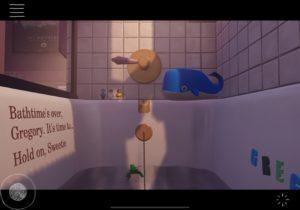Intro
I played What Remains of Edith Finch, developed by Giant Sparrow on my iPad and I really enjoyed it. Because the game contains elements of violence, blood, language, and drug reference, its target audience is people who are 13+ years old. It is appealing to people who are interested in mystery and detective games because the main plot of the game is to find out stories of members of a cursed family.
Formal Elements

This is a single-player game, with a 1 player vs. game interaction pattern. The player explores a family house and unlocks rooms. There are not so many explicit rules but the player’s movement is quite restricted. The player is allowed to walk and open very limited objects in the game. The procedure is quite straightforward – keep walking to wherever you can walk to. I think these rules and procedures are consistent with most walking simulator games because game mechanics and skills are not the most important elements of the game.
“Perhaps the walking sim’s greatest power is how it makes players recognize and consider such decisions and the way they influence gaming outcomes and environments, ” Nicole Clark suggested in A brief history of the “walking simulator,” gaming’s most detested genre. That being said, the more important elements of the game are the following:
Conflict – solving puzzles to explore the environment and learn about stories in the world.
Objective – the exploration of the stories and the world.
Outcome – the player learned about the stories and/or influenced the world.
Resources – the environment and the stories.
Boundary – the world presented in the game.
We can see from these elements that the game is a self-contained world. The whole game is all about the stories and the environment.
How does walking tell its story?
The protagonist can walk around the house and explore the rooms of family members. Each room is designed based on the member’s story and you can get a glimpse of the member’s life experience when the player first enters the room. Then the player can read something possessed by or related to that member. When the player reads it, the player will get into that member’s eye and witness the moment that this member died. There is also background music in the background to illustrate the emotions in that scene. I think the narrative architecture of this game is Enacting Narratives, in which the story is not very linear but episodic instead. The game has a broadly defined goal (understand how every member died) and the narrative is pushed by the character’s movement across the map (according to Game Design as Narrative Architecture by Henry Jenkins, which we read for May 3’s mindmap assignment).
One challenge of using this kind of narrative structure is that the player may not know what to do next and wander around. This would be boring and frustrating if a path isn’t found shortly. In What Remains of Edith Finch, the player is not totally left to explore with no cues. As the player walks, they can hear the protagonist’s narration about what she knew about the family history as the narration texts appear in the air or on some objects in the environment, implying where the player should go next.
Here is a series of screenshots of how the player enters a room, sees an object that can be read, picks it up, and gets into the memory of a family member.





Through these mechanics, the game provides the fun of narrative and discovery. The player can discover the narratives with their hands and eyes. This is a wonderful game play experience.
Moments of epic fails
I found the motor-control mini-games when I need to move some objects or catch something very difficult to do. For example, I was in the eyes of an eagle and I needed to catch a running rabbit. I didn’t know how the appropriately control the eagle so it took me much longer to do it than to solve a puzzle. It is very frustrating because it interrupted my flow in the game and dragged me out of the immersive experience of exploring the house.
Things I would change to make the game better
Danganronpa is a detective game that is also a mix of stories and motor-control parts. What I really liked is that they allowed the player to select a difficulty level for puzzles and a difficulty level for motor-control parts. So the player can customize their game according to their preference. I would have added this customization to Edith Finch to allow the user to choose whether they want a more puzzle-solving game or a mix of puzzles and action games.



